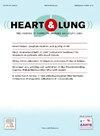中药治疗慢性肺源性心脏病:化痰活血法的系统评价和机理认识。
IF 2.4
4区 医学
Q2 CARDIAC & CARDIOVASCULAR SYSTEMS
引用次数: 0
摘要
背景:慢性肺源性心脏病(CPHD)严重影响全球健康,尤其是中老年人。在中国,中医 "化痰活血 "技术被广泛用于治疗慢性肺源性心脏病,但支持其疗效的高质量证据仍然有限:本研究旨在严格评估化痰活血法治疗 CPHD 的临床疗效,并阐明其主要中药成分的作用机制:方法:通过详细的中英文文献检索和严格的纳入和排除标准,筛选出 18 项随机对照试验(RCT)进行荟萃分析。我们采用关联规则分析法确定了 RPAB 的核心草药组合。这种方法对草药使用的频率和相关性进行统计分析。然后,我们分析了这些组合的化学成分,并通过网络药理学研究了它们对 CPHD 的潜在干预机制:结果:在改善 CPHD 患者的血气分析和肺功能以及降低血浆粘度方面,RPAB 与西药的组合优于单独使用西药的组合。确定的核心中药组合是黄芪(Fisch.)、川芎(Ligusticum chuanxiong Hort. ex S. H. Qiu & al.)和黄芩(Stellaria alsine Grimm (ALS))。这一组合针对 588 个治疗靶点和 27 个核心靶点。它影响了 34 个通路中的 10 个核心化合物,主要通过趋化因子信号通路和 JAK-STAT 信号通路:结论:RPAB与西药的结合能明显改善CPHD的治疗效果。该研究强调了 ALS 组合的治疗潜力,它通过多种途径重塑肺动脉、减少炎症和减轻氧化应激。这些见解支持了 RPAB 在 CPHD 治疗中的临床应用,并为研究和治疗开发开辟了新途径。本文章由计算机程序翻译,如有差异,请以英文原文为准。
Treating chronic pulmonary heart disease with traditional Chinese medicine: Systematic evaluation and mechanistic insights into the resolving phlegm and activating blood approach
Background
Chronic Pulmonary Heart Disease (CPHD) significantly impacts global health, especially among middle-aged and older adults. In China, the Traditional Chinese Medicine (TCM) technique of Resolving Phlegm and Activating Blood (RPAB) is widely used to treat CPHD, although high-quality evidence supporting its efficacy remains limited.
Objectives
The purpose of this study was to rigorously assess the clinical efficacy of RPAB for CPHD and elucidate the mechanisms underlying its primary herbal components.
Methods
Through a detailed search of literature in both Chinese and English and strict inclusion and exclusion criteria, 18 randomized controlled trials (RCTs) were selected for meta-analysis. We identified RPAB's core herbal combinations using association rule analysis. This method statistically analyzes the frequency and correlation of herbal medicine usage. We then analyzed the chemical components of these combinations and investigated their potential intervention mechanisms on CPHD through network pharmacology.
Results
The combination of RPAB with Western medicine was superior to Western medicine alone in improving blood gas analysis and pulmonary function and reducing plasma viscosity in CPHD patients. The core herbal combination identified was Astragalus membranaceus (Fisch.) Bunge, Ligusticum chuanxiong Hort. ex S. H. Qiu & al., and Stellaria alsine Grimm (ALS). This combination targeted 588 therapeutic and 27 core targets. It influenced ten core compounds across 34 pathways, primarily through the chemokine signaling pathway and the JAK-STAT signaling pathway.
Conclusion
RPAB with Western medicine significantly improves CPHD treatment outcomes. The study highlights the therapeutic potential of the ALS combination, which operates through multiple pathways to remodel pulmonary arteries, decrease inflammation, and lessen oxidative stress. These insights support the clinical application of RPAB in CPHD treatment and open new avenues for research and therapeutic development.
求助全文
通过发布文献求助,成功后即可免费获取论文全文。
去求助
来源期刊

Heart & Lung
医学-呼吸系统
CiteScore
4.60
自引率
3.60%
发文量
184
审稿时长
35 days
期刊介绍:
Heart & Lung: The Journal of Cardiopulmonary and Acute Care, the official publication of The American Association of Heart Failure Nurses, presents original, peer-reviewed articles on techniques, advances, investigations, and observations related to the care of patients with acute and critical illness and patients with chronic cardiac or pulmonary disorders.
The Journal''s acute care articles focus on the care of hospitalized patients, including those in the critical and acute care settings. Because most patients who are hospitalized in acute and critical care settings have chronic conditions, we are also interested in the chronically critically ill, the care of patients with chronic cardiopulmonary disorders, their rehabilitation, and disease prevention. The Journal''s heart failure articles focus on all aspects of the care of patients with this condition. Manuscripts that are relevant to populations across the human lifespan are welcome.
 求助内容:
求助内容: 应助结果提醒方式:
应助结果提醒方式:


